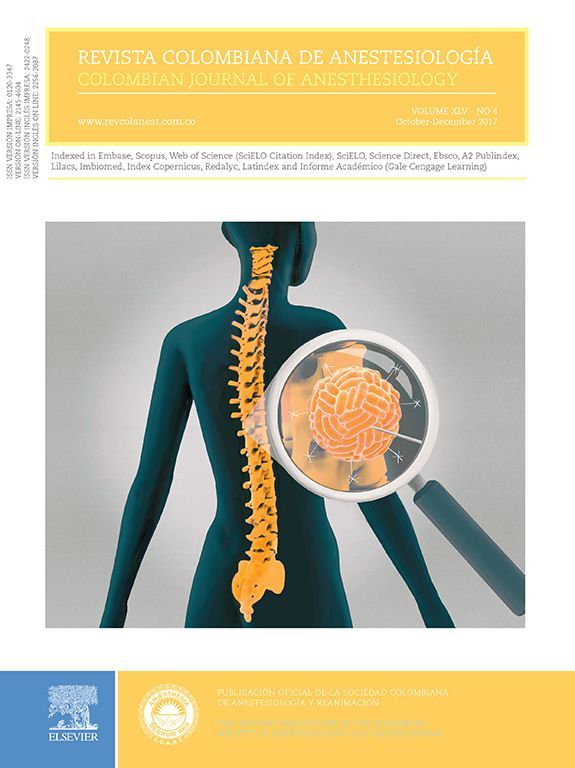Zika is a flavivirus transmitted by the Aedes spp. mosquito, characterized by an asymptomatic presentation in 80% of the cases.1 When symptoms develop, the primary manifestation is a macopapular rash.2 Zika is phylogenetically related to other viruses such as dengue, yellow fever, and West Nile.3 In Colombia, the endemic region for dengue and chikungunya is considered potentially endemic for Zika.4 The relevance of the virus lies in the associated neurological sequelae including microcephaly of the newborn, and Guillain–Barré syndrome in adults.5 Furthermore, in view of its re-emergence and association to these sequelae, Zika represents a medical challenge that goes beyond a public health concern, but involves other clinical specialties.
Zika was reported for the first time in 1947 in Uganda, and continued to appear in epidemic outbreaks in Asia and Africa. In 2007 the first outbreak of the virus was reported outside these continents, in the Northern Pacific region and it was diagnosed in the laboratory because initially it was thought to be dengue.6 In 2013, French Polynesia registered a Zika outbreak that was also diagnosed in the laboratory.7 This outbreak lasted until April 2014, with a simultaneous increased incidence of Guillain–Barré, suggesting a probable association between the two conditions.5 Then, in 2015, an unexpected rise in the number of cases similar to dengue associated with increasing numbers of newborn babies with microcephaly, alerted the clinicians and healthcare authorities in Brazil about the possibility of a new virus associated with neurological complications.2,8 Until 2015 there have been no cases reported of microcephaly associated with Zika2 while there have reports of Guillain–Barré cases among patients infected with West Nile, Japanese encephalitis, chikungunya, and dengue. However, it was not until the epidemic outbreak in 2014 that the association was made between Zika and this complication.5 In February 2016, the World Health Organization declared Zika a Public Health Emergency of International Concern. Since then, worldwide efforts have been brought together to learn more about the virus and to promote research in the area of Zika, Guillain–Barré and microcephaly.8,9
Guillain–Barré syndrome is currently the primary cause of acute flaccid paralysis in the world since the polio vaccine. This condition presents clinically with paralysis and arreflexia, and elevated proteins in the cerebrospinal fluid, with normal serum counts. It may be the result of an autoimmune response targeting mainly the peripheral nerves, so the patients present weakness of the lower limbs or of the muscles innervated by the cranial nerves.10 In about 75% of the cases, the clinical presentation is preceded by diarrhea or respiratory tract infection. The most commonly associated infectious agents are Campylobacter jejuni, cytomegalovirus, Epstein–Barr virus, varicella zoster and Mycoplasma pneumoniae. There are two subtypes of Guillain–Barré: acute inflammatory demyelinating polyneuropathy and acute motor axonal neuropathy, a classification based on the results of nerve conduction tests.10
Clinically, the most relevant differences between the two subtypes are a longer progression and the need for mechanical ventilation in the case of demyelinating disease, while the axonal subtype does not present significant autonomic dysfunction, and have a longer recovery.10 A meta-analysis on Guillain–Barré in Western countries showed that the incidence had increased from 0.62 to 2.66 cases per person/year in every age group. Likewise, the proportion of males versus females was 1.78.11 Additionally, the subtypes distribution varied according to the geographical region, with almost 90% of the cases of polyneuropathy being reported in Europe and North America, and between 30 and 65% of the cases of neuropathy in the Asian countries and Mexico.5 In Colombia, the reported cases before the Zika epidemic in the years 2015–2016 showed a misclassification in 58% of the cases. Among the classified cases, neuropathies and polyneuropathies has similar rates of occurrence (17%).12 Another Colombian study,13 followed a series of 19 cases admitted to the ICU with symptoms compatible with Guillain–Barré and a history of Zika infection. The relationship of occurrence of polyneuropathy and neuropathy was 5:7. However, a study of cases and controls which included 68 patients14 and showed a 78% prevalence of demyelinating polyneuropahty subtype in 46 patients who had conduction nerve tests.
Bearing in mind this situation, what are the implications for anesthesiologists facing Zika cases? With regards to the patients either suspected or with Zika, or with a Dengue-like infection, the medical record becomes crucial to give the anesthesiologist a diagnostic basis for the pre-surgical evaluation of the patient. Since most cases might be asymptomatic, the epidemiological component becomes relevant to guide the clinic. Questions must be asked about the place of origin and places visited in the last 10 days, traveling to endemic countries, trips across borders, contact with sick people or with similar symptoms, and recent contact with Aedes. Since the virus is also transmitted sexually, questions should be asked about whether the patient has had any intercourse during his/her visits to endemic areas for Zika, or has had any sexual contact with people coming from those areas. For example, in the Colombian study of cases and controls, two patients were asymptomatic and were classified as cases because they came from an endemic area.14
The same study14 revealed that 96% of the cases had a history of Zika infection over the past month. It should be kept in mind that when the patient develops symptoms, these may present three to twelve days after the virus infection. Furthermore, the medical record shall include questions such as the presence of rash, non-suppurative conjunctivitis, photophobia, and fever.3,4 This will enable a differential diagnosis with dengue y chikungunya. It must be kept in mind that dengue is characterized by high fever, headache, retro-orbital pain, bone pain, myalgia, rash, and occasionally hemorrhagic manifestations. Whereas polyarthalgia, high fever, and rash are presented in chikungunya.15 The characteristics of Guillain–Barré due to infection from these viruses are different than Zika. In the case of dengue, the frequency of presentation is very low as compared to encephalitis, and usually occurs after the acute phase of the infection.16 In patients with chikungunya, the presentation is rare and late.17 It is important when filling out the medical record to pay attention to the information that will later be useful to public health specialists for doing epidemiological surveillance. The first Zika cases followed in Brazil, and the suspected association with neurological sequelae, led the clinicians to undertake research carefully in the light of unusual events identified in their practices. The public health specialists began to establish the causality and the scope of the epidemics, and the reference laboratories in the country played a key role in the identification of the virus.8
The test of choice for laboratory confirmation is the Reverse Transcription Polymerase Chain Reaction that identifies the virus in the urine, blood, and other fluids, up to two weeks after the onset of symptoms. In the semen the virus may be identified up to 188 after.5 However, in the Colombian setting these tests are only done in two cases: (1) as part of a sentinel surveillance of the virus, and (2) in priority populations (pregnant women, people over 65 years old, infants less than one year old, people with comorbidities, and all cases of mortality).18 In accordance with the Centers for Disease Control (CDC),19 the antibodies may be measured in serum or urine. The guidelines establish that in case of negative results, an ELISA (Enzyme-Linked ImmunoSorbent Assay) serology shall be performed to detect anti Zika immunoglobulins (IgM and IgG).20 The final confirmation is done with the Plaque Reduction Neutralization Test. In Colombia the ELISA test may be done on day 6 following the occurrence of symptoms. However, the validity of this test is low since there might be cross-reactions with other flaviviruses,13 particularly with dengue.21 Furthermore, for all patients with Zika, biosecurity measures must be strict, avoiding direct contact with the patient's body fluids since the virus may be present in practically all of them, with the exception of sweat. Proper hand washing, use of fluid-resistant garments, good sampling and venous catheterization practices, proper hospital waste management, and use of gloves, antiseptics, and alcohol-based disinfectant gels. These personal protective measures must be reinforced in the pre-surgical setting.22
In all Zika cases it is necessary to pay attention to any symptoms leading to severe outcomes such as dehydration, bleeding, severe joint pain and skin ulcers. The use of non-steroidal anti-inflammatory agents shall be avoided until dengue infection is ruled out.4 Other complications such as myocarditis, myocardial dysfunction, arrhythmia, and cardiovascular collapse secondary to multiple organ failure, have all been seen in patients with dengue and yellow fever; hence, the recommendation is that Zika patients be monitored to prevent these complications.3 The anesthesiologist must keep in mind that any Zika patient with symptoms compatible with Guillain–Barré, should undergo a strict pre-anesthesia evaluation and avoid using succinylcholine because it may lead to hyperkalemia and potential autonomic dysfunction. Furthermore, the use of epidural anesthesia is not recommended since there is evidence that it may further impair patients with Guillain–Barré.3 Similarly, in some cases the infection presents neurological syndromes such as acute myelitis and meningoencephalitis, as well as respiratory symptoms such as compromised respiratory mechanics, airway obstruction, impaired swallowing or breathing. Therefore, under these conditions and in other severe cases, advanced life support is needed, and ideal as the mainstay of therapy.12
Finally, Zika and Guillain–Barré patients will require adequate diagnosis and medical management, both pre- and post-surgery, in addition to timely referral to the appropriate healthcare practitioners for medical, psychological, and rehabilitation support and follow-up. All of these factors will help patients in their favorable progress and successful recovery. Keeping in mind that this is the first approach within the Social Security System in Health (SGGSS) to prevent these patients from developing major neurological consequences or have a fatal outcome. The clinician is called to use a more epidemiological vision when dealing with these patients. First, because many of Zika cases are asymptomatic and it is likely that the initial diagnosis will be Guillain–Barré syndrome, rather than the infection. Second, because a history of migration and contact with the vector will orient the practitioner to make the correct diagnosis of the infection. In the light of the current conditions of the Colombian healthcare system, the role of the clinician is fundamental for identifying and managing these cases and for reporting to the National System of Public Health Surveillance (SIVIGILA).
Conflicts of interestThe author has no conflicts of interest to declare.
FundingThe author was not sponsored to carry out this article.
Please cite this article as: Pacheco-Coral AP. Zika, Guillain–Barré y anestesiología: un punto de intersección entre la salud pública y la práctica clínica. Rev Colomb Anestesiol. 2017;45:269–271.



